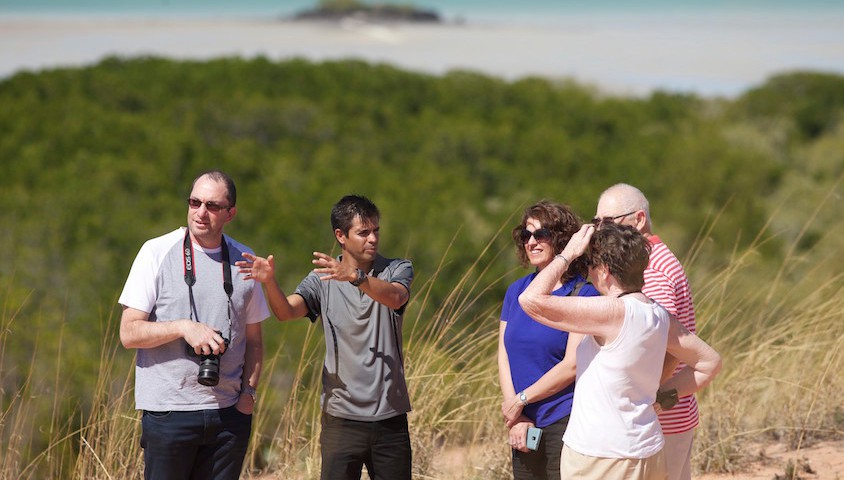Recently, there have been discussions in the media regarding the importance of heritage and place. With Australia’s population set to grow significantly over the coming years, the question of preserving heritage while developing the country is an issue that demands attention. Fortunately, there are individuals who are already dedicating themselves to conserving and passing on cultural heritage.
After years working in curatorship and as a cultural development project officer for Yawuru traditional owners, local Broome identity Bart Pigram has founded his own cultural and environmental tours. Narlijia, meaning ‘true for you’ in the Yawuru language, seeks to provide visitors to the West Kimberley with an insight into the heritage of the southern Dampier Peninsula, the country where Bart was born and raised.
Bart, thank you for taking the time to discuss your work. You run two distinct tours, is that right?
Yes, there are two Narlijia tours. The first one is a heritage walk around the Broome township, which considers what Roebuck Bay [where Broome is situated] was like before settlement. It then explores the unique history of Broome as a frontier and pearl diving town. The other focuses far more on the beautiful natural surrounds of Broome and the Dampier Peninsula. Walking through mangrove forest at low tide, we discuss the importance of the environment to Aboriginal people and its place in Dreaming stories as well.
How did you come to form the idea of Narlijia?
I was inspired partly by Paddy Roe OAM, lawman of the Goolarabooloo people whose lands are situated close to Broome. Paddy created the Lurujarri Trail, which is dreaming and heritage trail running about one hundred kilometres north from town. Paddy recognised the value in sharing cultural heritage and knew that, to help preserve the land, it was imperative to share this knowledge with non-Indigenous people. My tours, I feel, are like a smaller operation but with the same goal in mind: educating and preserving heritage.
By allowing different ideas to be shared and discussed, do you think there is some form of reconciliation taking place through the tours?
I definitely think so. These tours, like heritage trails, are reconciliation in practice. I feel as if they’re a way of bringing different parts of Australia together. Years ago, when I was first walking the Lurajarri Trail, there were quite a few other walkers from the more urban areas in Australia. And the thing that really hit me was how attentive these city folk were – how eager they were to learn more about Aboriginal culture. Seeing everything that I grew up with from their perspective showed me just how effective heritage tours could be to preserving all these things that I love. The way to get someone to really appreciate something is through showing them personally, I feel.
I was thinking just recently that there are many people who would like to connect with Aboriginal culture but the opportunity just isn’t there, particularly in the more urban areas on the East coast. Do you think that society in the Top End is more in tune with traditional culture?
Well, in some ways yes, because it’s difficult to miss – I mean, Yawuru language is taught in our schools in Broome, for example. It’s all around you. However, this might not be the case in the future. It’s not just the cities that are becoming more concentrated. Broome – for the first time – is developing suburbs, as are other large rural towns across the Top End. In some ways, this is a great thing, because it shows just how many people are recognising the beauty of the north as a place to live. But I don’t want people moving up north just because it’s nice and picturesque. I’d like to see them embracing the history and culture of the place they’ve decided to settle down. It’s heartening to see this already happening in our schools, and I hope that my tours are helping people really appreciate what was here before development started.
And are you confident of that?
Absolutely. For example, you can already see the appreciation of culture through the work of the scientific community in the Kimberley. By employing modern skills while learning off the ancient trial and error ideas of Aboriginal Australia, scientists are challenging and forming new ideas all the time. They’ve taken the time to respect and learn and I hope that will be the same with many people who move north. We just have to reinforce the importance of country through education. I think it’s something our leaders can get on board with.
Questions about leadership are being asked recently throughout the media, given the recent federal election. It’s often felt by people that there’s a disconnect between politicians and the electorate. What’s your take on that, in regards to conservation and heritage?
Look, from my experiences up here, I really wonder sometimes how much integration and interaction politicians have had with communities and traditional owners. I think if they were to come to areas that they’ve set aside for mining and development, and if they were to camp out there and hear the stories of the place they might think a little differently about their actions and their policies.
What advice would you give them?
That we as Australians have to be smart about how our society adapts to change in the future. Development is going to be one of the major issues over the coming years. The population’s growing, not just here but around the world, and we need to earmark areas which will help us grow and adapt without losing any of our heritage. I think it would be stupid not to invest significantly in tourism in Broome and across the north. Tourism is close to being the world’s biggest industry – and it’s renewable! I hope that our leaders at least recognise that.
You can learn more about Bart’s tours can be viewed at the Narlijia website.


